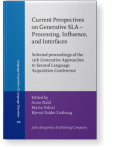Chapter 15
Multilingualism, linguistic diversity, and English in India
Effects on underprivileged children’s linguistic and cognitive development
This chapter explores bi-/multilingualism in the Indian context, summarizing findings from the MultiLiLa project
which addressed the persistent challenge of low learning outcomes in India. The research covered diverse geographical settings and
employed a comprehensive methodology. We present quantitative findings from classroom observations, emphasizing the extent of English
input in primary school. Linking learners’ home language profiles, school language exposure, and performance on cognitive and
linguistic tasks, the chapter also explores English narrative retellings as a lens for understanding the use of vocabulary and
morphosyntax. The findings provide valuable insights into the dynamics of language input and its implications for bilingual education
in India. The chapter contributes to the broader discourse on bilingualism and sets the stage for future research.
Article outline
- 1.Introduction
- 1.1Background on the MultiLiLa project
- 1.2Profile of children: Bilingual/multilingual vs. monolingual households
- 2.Background on studies conducted and methods
- 2.1Background and methods on classroom observations: English language input in Indian classrooms
- 2.2Background and methods investigating learners’ performance on cognitive tasks
- 2.3Learners’ performance on linguistic tasks: Background and methods
- 2.3.1Literacy, reading comprehension, and oral (narrative) comprehension
- 2.3.2The role of oral language input on vocabulary and morphosyntax
- 3.Findings from the three studies
- 3.1Findings from classroom observations: The role of oral language input in classrooms
- 3.2Findings from learners’ performance on cognitive tasks: Effects of linguistic diversity/multilingualism
- 3.3Findings from learners’ performance on linguistic tasks
- 3.3.1Literacy, reading comprehension, and oral (narrative) comprehension
- 3.3.2The role of oral language input on vocabulary and morphosyntax
- 4.Summary, conclusions, and open questions
-
Acknowledgements
-
Notes
-
References
This content is being prepared for publication; it may be subject to changes.
